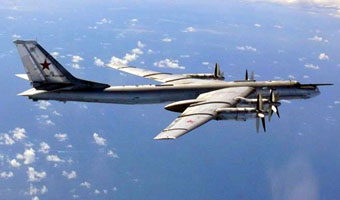
Russian Bombers Stray Into British Airspace (Again)
| published February 19, 2015 |
By Thursday Review staff
For the second time in as many months, the British air force intervened when Russian bombers approached—and nearly crossed into—British sovereign airspace.
On Thursday the RAF scrambled a squadron of Typhoon fighter jets to intercede in the flight paths of two Russian “Bear” bombers as they crossed over the English Channel. The bombers entered commercial and civilian flight paths, forcing London’s air traffic control to briefly reroute commercial air traffic, and triggering a rapid response by the RAF. The British Typhoons were able to escort the Russian bombers away from the area of British airspace and out of “the U.K. area of interest,” but the incident is just one of many recent altercations between Russian pilots and British pilots.
The crisis in the Ukraine, and that country’s increasingly violent civil war, have raised tensions among NATO nations and NATO operations. Russian bombers, fighters and reconnaissance planes have, on dozens of occasions since last spring, deliberately or inadvertently entered the airspace of countries which are part of the NATO alliance.
Last month, after a similar incident involving Russian bombers whose flight paths put them perilously close to British sovereign airspace, London demanded that the Russian ambassador offer an explanation of the violation. Britain also insisted that all such dangerous air provocations stop. There were similar incidents involving Russian planes entering British airspace in November of 2014. Over the course of three days in November, some six Russian planes strayed or ventured into the skies extremely close to Britain’s airspace. During those incidents, one pair of Russian bombers flew across the North Sea, turned south along the Atlantic, then briefly entered the airspace of Portugal. A month before that, several contingents of Russian planes crossed the Black Sea and entered Turkish airspace, where they remained until met by Turkish fighter jets.
The war in the Ukraine, which has raged for nearly one year, has driven a wedge between Russia and dozens of European countries. The United States and other countries have imposed harsh economic sanctions on Russia, which has been supporting and supplying pro-Russian militant rebels in their fight with the Ukrainian army loyal to Kiev. Russian President Vladimir Putin has repeatedly denied that Russia has offered supplies or assistance to the militants.
Military aviation experts suggest that the overflights and close flybys are meant as a means of testing NATO and European defenses, but also are crafted as a sort of blunt communication by Putin and the hardliners in Moscow to the EU and NATO: Russia is neither cowed nor intimidated by economic sanctions or by threats from NATO regarding the Ukraine.
But some worry that the apparently deliberate Russian testing of air defenses may signal Putin’s willingness to resort, if cornered or badgered, into military action. Relations between Russia and the EU are at an all-time low, and relations between Russia and the United States (and the United Kingdom), are at their worst level since the end of the Cold War.
NATO countries have been reporting an increase in aviation provocations for months, even since economic sanctions began to put the squeeze on Russia’s economy. Military and aviation experts worry that such deliberate actions could lead to miscalculation or misjudgment by pilots or by commanders, and any shoot-down or other incident could easily escalate.
Related Thursday Review articles:
Ukraine Violence Escalates; Thursday Review staff; Thursday Review; February 3, 2015.
